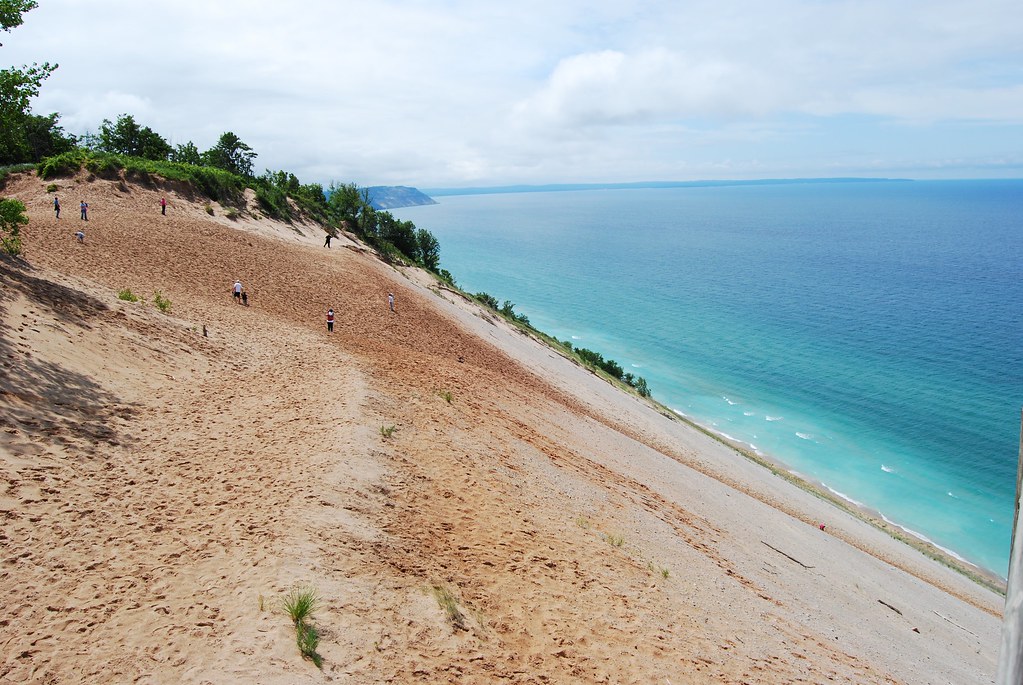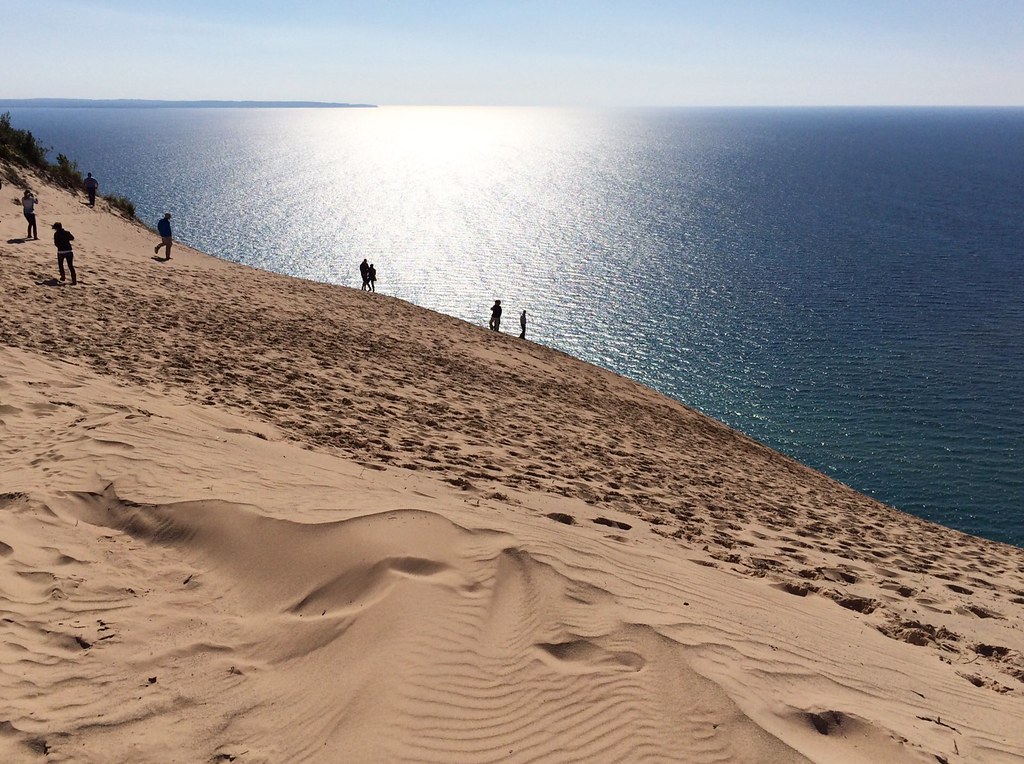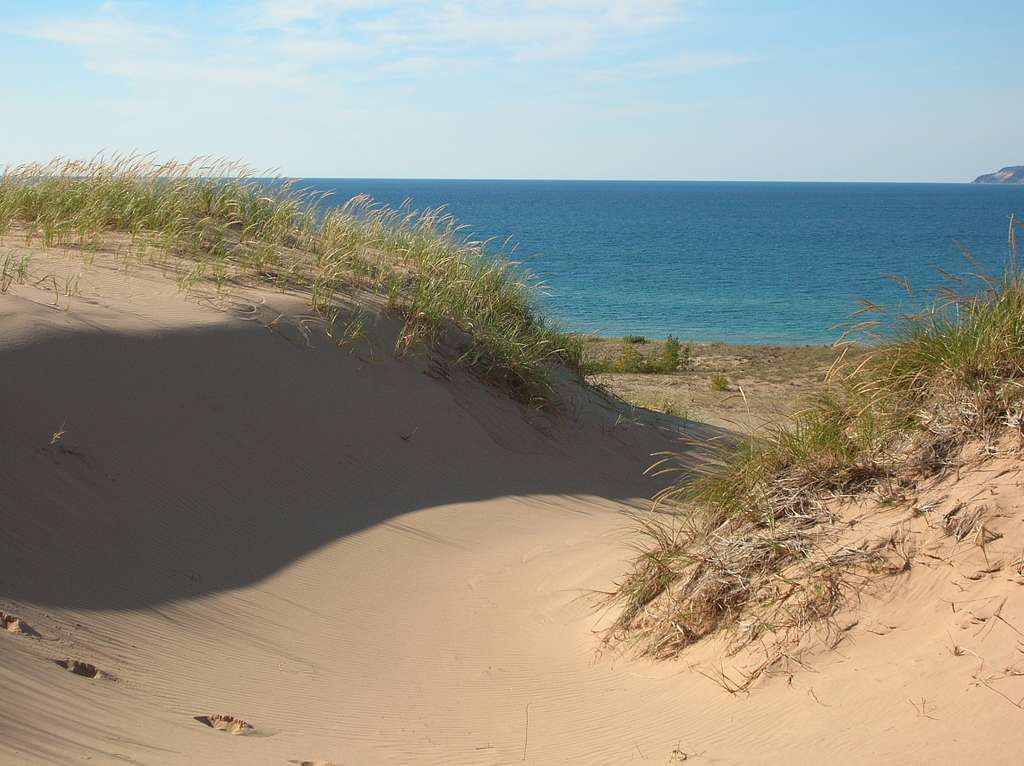Exploring Michigan’s Dunes
By Alecia Croft | Marketing Assistant

Michigan has more sand dunes on freshwater than anyplace else in the world. As the earth’s surface shifted over thousands of years, so did the sand. West winds sent sand from the beaches up to the shores, and beyond, forming sand dunes which are seen along the lakes today.
Types of Sand Dunes
There are four types of sand dunes in the state, all with unique differences.
Foredunes sit near the water’s edge when water levels are low. When water levels increase, they erode.
Parabolic Dunes are stabilized by vegetation, and have dips, where sand sits. Parabolic dunes are commonly found in Michigan’s lower peninsula, along Lake Michigan.
Perched Dunes sit high up and are “perched,” sometimes hundreds of feet, above the water. They can form bluffs and are impacted heavily by water levels.
Dune and Swale are found diving up and down, typically among wetlands, not major lakes, and are often covered in vegetation and forests.
Sleeping Bear National Lakeshore
Located near Empire, Michigan, the massive Sleeping Bear perched dunes sit high up above the northwest side of Lake Michigan’s shore. People flock to the area to climb what is called “an active dune,” which did not originate from in the lake, like other dunes in Northern Michigan, which formed over years of the earth moving and sand blowing up from the lakeshores. The designated climbing dunes are comprised of sand that’s migrated from other nearby dunes on the Sleeping Bear Plateau, which stretches for four square miles.
Dune Climb
People come to Sleeping Bear Dunes to enjoy climbing and playing on the dunes year-round. In the summertime they draw in people from far and wide. Those who stand atop the first dune after an invigorating climb will be able to see Glen Lake in the distance. After tackling the second dune, climbers have another three to go before they make it to the shore of Lake Michigan. It typically takes several hours to complete the climb. Visitors should take note that if they go down the dunes, the climb back up is quite strenuous, and if they cannot make it up on their own there is a fee to be rescued.
For those who want to observe the climb, they can utilize the restroom facilities and pick up something at the bookstore to remember the day by near the picnic area at the base of the dune (these amenities are available only during the summer). Pet owners should note that dogs are not allowed on the sand dunes .
Take a Hike
The beach makes for a beautiful walk or run, but the preserve also has plenty of hiking trails. Empire Bluff Trail leads to one of the famous lookouts. The hills make the trail moderately challenging but is easier than climbing the dunes. The trail is three fourths of a mile each way and takes about an hour to complete, depending on how long hikers want to pause to take in the views.
Hikers who take Pyramid Point Trail enjoy bird’s-eye views of Lake Michigan from the lookout, just half a mile after they begin the hike. Manitou Passage, and the Manitou Islands, can also be seen from Pyramid Point on a clear day. Most hikers turn back after taking in the beauty of the lake, creating a round-trip journey of just over a mile. Much like Empire Bluff Trail, this trail is also hilly and moderately challenging. The hiking trails lead to high dunes, which hikers are advised not to venture down.
Arcadia Dunes
Sitting within Benzie and Manistee Counties are the Arcadia Dunes. These dunes are found in The C.S. Mott Nature Preserve, which not only preserves miles of hiking and biking trails, but also ensures the preservation of nearby functioning farm land.
Hiking
There are several trail options on the preserve, but Old Baldy takes hikers along on the dunes and offers fabulous views of Lake Michigan. The trail is not difficult and takes just under a mile round trip. Visitors can spot hundreds of different species of birds on their trek, which is just one more reason to go explore the Arcadia dunes.
Bird Watching
The Sleeping Bear Birding Trail (SBBT) runs through the Arcadia Dunes and is part of the Sleeping Bear National Lakeshore. The trail runs for over 120 miles, offering visitors ample space to spot beautiful birds, such as Horned Lark, Eastern Kingbird, American Kestrel, and more. The endangered shorebird, the Piping Plover, lives along the trail. Piping Plovers nest on beaches, preferably in areas with cobblestone. They migrate to the Gulf Coast for the winter. Visitors enjoy trying to catch a glimpse of the Piping Plovers, Grasshopper Sparrows, Upland Sandpipers, and other bird species from the SBBT. During migratory flights, visitors watch for several types of sparrows, such as the White-crowned Sparrow, White-throated Sparrow, and more.

Silver Lake Sand Dunes
The sand dunes in the Silver Lake State Park near Hart, Michigan span just under 3,000 acres, and nearly 1,900 acres of that are accessible to the public. The Silver Lake Sand Dunes can change on a dime and are one of the biggest deposits of “living dunes” in the state. The dunes have five different designated areas, including over 400 acres for off-roading (vehicles must be approved and meet the park’s requirements). On the north side vehicles are prohibited, and visitors can enjoy sinking their feet into the sand from the top of the dune that divides Silver Lake and Lake Michigan.
Visit Little Sable Lighthouse
On the south side of the dunes sits Little Sable Lighthouse. Visitors can make their way up the tower stairs if they wish to enjoy a tour. There is a specific parking area for those interested in touring the lighthouse. In addition, a beach, picnic area, and restrooms are available for visitors.
Take a Dune Ride
Mac Wood’s Dune Ride Tours are a family-friendly option for those who do not wish to drive their own ORV on the dunes. Each tour is educational and memorable. From the lake to one of the highest dunes, the 40-minute tour is one that all visitors will remember.
Set out on Horseback
Equine enthusiasts can register, starting in September, and reserve a spot to ride their own horse along the Silver Lake Sand Dunes during the month of November . Riders must trailer their own horse, and pay a small fee, to enjoy riding along the lakeshore.
Sand Dunes in Saugatuck
Saugatuck Dunes State Park includes the Patty Birkholz Natural Area, which spans 300 acres and protects the sand dunes and endangered plants. The State Park, which is roughly 10 miles southwest of Holland, has hiking trails for visitors to enjoy.
Go for a Hike
There are several hiking trails at the State Park. The North Trail is around two and a half miles in full and often takes around 45 minutes to complete. Hikers make their way through the grassy dunes and sand as they keep an eye out for critters like rabbits, chipmunks, white-tailed deer, and other animals. Arriving at the massive dunes makes this hike worthwhile.
Visitors often combine trails, beginning on the North Trail, making their way down to the beach, and then to the Livingston Trail, which goes through the forest and sand dunes.
Take a Ride on the Dunes
Make a reservation at Saugatuck Dune Rides. Visitors spend 40 minutes being entertained, and learning about the area’s plants and wildlife, while they relax and enjoy being taken on a cruise through the dunes in a bench seat open-top truck. It’s a great option for those who don’t feel like hiking.
Take a Tour
Discover the history of the 1920s Felt Mansion. The Felt Estate is near the State Park and the Shores Acres Township Park . Visitors can take guided group or private tours of the mansion or explore on their own. Whichever way visitors choose, they are sure to learn about the restoration process, architecture, and history of the estate. The mansion can be booked for private parties and events, so it is wise to check the schedule ahead of time. Throughout the year various events occur at the mansion, such as a summer concert series and “spooky” Hauntings & History nights in the fall.
After enjoying a tour of the Felt Mansion, head to the township park’s mountain bike trail, play disc golf on the course, or enjoy the other outdoor activities they have to offer.
The history and topography of Northern Michigan, much like the area’s sand dunes, are unique. Whether visitors want to embark on a Dune Climb, stand on a dune that sits between an inland and Great Lake, take a ride on the dunes, or go on a tour, they are sure to make memories when they visit Michigan’s sand dunes and towns that they sit within.



